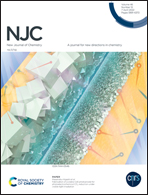A new FeOCl/graphene quantum dot catalyst for peroxymonosulfate activation to efficiently remove organic pollutants and inactivate Escherichia coli†
Abstract
The sulfate radical-based advanced oxidation processes (SR-AOPs) are well-established and efficient techniques for the degradation of organic pollutants. Fe2+ is used as an environmentally friendly and cost-effective catalyst for activating peroxymonosulfate (PMS) to generate sulfate radicals (SO4−˙). In some past studies, the slow process of reducing Fe3+ to Fe2+ reduced the overall reaction rate of the SR-AOP system. To overcome this challenge, in this work, we for the first time fabricated a new composite activator, FeOCl decorated by graphene quantum dots (GQDs), by a facile method for activating PMS. The experimental results demonstrate that the as-prepared FeOCl/GQD catalysts can efficiently degrade organic pollutants and kill Escherichia coli through activating PMS to generate active species. Notably, the FeOCl/(16.7 wt%) GQD composite can activate PMS to degrade organics (97.8% of RhB within 30 min) and inactivate E. coli (99.1% within 10 min) with a pH range from 3 to 11. Moreover, mechanism analyses showed that the active species were SO4−˙, ˙OH, 1O2 and O2−˙ in the FeOCl/(16.7 wt%) GQDs + PMS system, and SO4−˙ and 1O2 were proved to be the main active species. The addition of GQDs promoted the reduction of Fe3+ to Fe2+, thereby accelerating the degradation rate. Our study suggests that the promising strategy of exploiting highly efficient AOP platforms has many applications.



 Please wait while we load your content...
Please wait while we load your content...